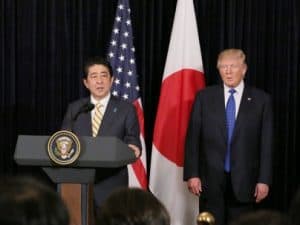
The US participated in the Trans-Pacific Partnership negotiations during the Obama administration, but Trump and Hillary Clinton, competing for the protectionist crown, both campaigned against it.
Trade correspondent L.C.’s weekly report follows
President Trump re-stated this week his interest in taking a second shot at joining the Trans-Pacific Partnership (now called the Comprehensive & Progressive TPP). One of his first acts as President was to withdraw from the TPP negotiations. The administration’s new rationale for joining the TPP is that it represents the best opportunity for the US to unify the Pacific region in the mounting confrontation with Beijing. In fact, according to some press accounts, “Trump has been quizzing people for several weeks about whether they think he made a big mistake by dumping TPP, especially now that he is trying to put pressure on China…. [He] realizes he’d have a much stronger position against China if he had the support of TPP’s current 11 members…. [He] realizes he screwed it up.”
But Washington could have a difficult time rejoining the TPP on conditions as favorable as they were when it left, let alone winning new concessions. The US Section 232 steel and aluminum tariffs could be a strong bargaining point, however. If the US pledges to give a permanent exemption – no quotas or tariffs – to all TPP countries (and perhaps also agree to exempt them from any future safeguards), they might agree to some “face-saving” changes.
One additional TPP provision that would be a win-win for all TPP members would be an agreement that any move by China to punish by trade or boycott action any one TPP member would be countered by all members retaliating in unison. Such a provision would have prevented China from beating down South Korea when the latter displeased China by accepting a THAAD anti-missile deployment. With no other country coming to its aid, South Korea was forced to back down.
There are complications in Washington, however. First, it is unclear if a new TPP deal would be covered by the 2015 Trade Promotion Authority legislation that is about to be renewed. The President’s request for the renewal didn’t say he would seek to join the TPP. Then, even if most Republicans are enthusiastic, many Democrats – led by their House and Senate leaders – still oppose the TPP, as does organized labor. AFL-CIO President Richard Trumka issued a statement criticizing the President’s renewed interest. A TPP deal might have a tough time in Congress – especially if the Democrats gain control of either chamber in the November elections. That means that if the Administration is serious, it will have to act very quickly if it wishes to have a TPP deal considered by the current Congress.
Upcoming meeting with Japanese Prime Minister Abe

Japanese Prime Minister Abe and President Trump met at Mar-a-Lago over a year ago. Abe will visit Trump there again this April 17th-18th
President Trump will be meeting with Prime Minister Abe at Mar-a-Lago on April 17th-18th. Their conversation will likely clarify the options for the US to rejoin the TPP. Abe is a strong supporter of establishing the existing TPP-11 (the agreement minus the US). But he is also a strong supporter of the US joining, albeit belatedly.
Tokyo wants the US in the pact for strategic reasons. This would also remove US pressure on Japan for a bilateral US-Japan FTA, it would ease trade tensions in Asia, and it could resolve the Section 232 tariff situation in which Japan is the one close ally not temporarily exempted.
Prime Minister Abe arrives in the US with some negotiating advantages besides his kingpin role in the present TPP-11. The Japan-EU free trade agreement (FTA) that was negotiated late last year will be signed in Brussels in July.
China’s game
Beijing has a long history of promising to undertake changes that either never materialize or do so in a form not anticipated. Hence, the “promise fatigue” that has set in among China’s counter-parties. Beijing is usually ready to talk, hold “dialogues” and forums with other governments — but not follow through with action. Or to follow through only with reforms that fit the purposes of the Chinese regime. Or to offer small changes that are taken to the bank by trading partners — who are then deflected from pursuing their more consequential demands.
The risk for the US is that it has so far not paid enough attention to the pleas from Congress and the private sector to enlist allies, in particular Japan and the EU, in the battle against China’s abuses. The US did file a WTO case, and Japan and the EU on their own initiative have asked to participate as third parties on the US side. But that’s not enough to erase the aftertaste of initial US unilateral actions. Taking advantage of this situation, China is engaging in outreach to Japan and the EU in an effort to split Washington from its allies.

The Chinese electronics company Huawei is being promoted by the Chinese state to dominate the next generation “5G” wireless standard and its hardware
Chinese President Xi Jinping’s widely publicized April 9th speech in Hainan –while dripping with paeans to free trade, didn’t address the key complaints of the US, Japan, and the EU: China’s subsidies, its many state-controlled enterprises, and its favoritism to “national champion” industries included in the Made in China 2025 initiative.
US response
The Administration reportedly may announce its response under US trade law Section 301 as early as this coming week. This would include a list of Chinese exports to be targeted for 25% tariffs under the $100 billion tranche that the President announced last week — as the follow-on to the already announced $50 billion in Chinese imports to be hit with tariffs. Tightened restrictions on Chinese investment in the US will also likely be announced.
The use of tariffs and the escalation of the US-China trade conflict have alarmed much of the private sector and many members of Congress, especially Republicans from farm states. They have largely rejected the President’s offer to develop a financing mechanism to give government assistance to farmers who lose export markets to foreign retaliation. They want to see the White House find a solution before the Section 301 tariffs and Chinese retaliation become a reality. They would not object to a “declare victory and go home” strategy even if it doesn’t stop China’s tech and IP abuses because they are worried that Chinese retaliation could lead to a collapse of crop prices and the US commodities sector just months before the midterm elections.
Other news
The EU offer. The EU is reportedly developing a plan to leverage US interest in a new trade deal with Europe to win permanent exemption from the Section 232 steel and aluminum tariffs. Brussels would propose that it engage with the US in a scoping exercise (feasibility study) as an initial step toward launching talks for a new FTA.
In talks with Washington, Brussels would be in a good position, having recently concluded free trade agreements with Canada and Japan.
The Summit of the Americas. With Trump and Lighthizer absent, the Summit of the Americas was not the anticipated occasion for intensive NAFTA discussions. The overall focus was on halting corruption and dealing with the crisis in Venezuela. Not much appears to have been accomplished on either.
Click here to go to the previous Founders Broadsheet post (“President Trump’s Best of Weeks, Worst of Weeks”)

Leave a Reply